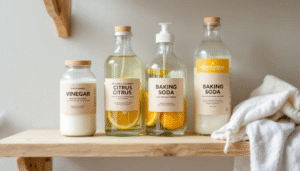Take a slow look around your living space. Does your eye land on surfaces clear and calm, or does it bounce from pile to pile—a stack of mail on the kitchen counter, shoes by the door, clothes draped over a chair, shelves overflowing with objects? For many, this slow accumulation of “stuff” creates a constant, low-grade hum of visual and mental noise. It’s the silent stressor that whispers, “your work is never done.”
In a place as beautiful as Naples, your home should be your personal sanctuary, a place of peace and restoration. But it’s difficult to feel serene in a space that feels chaotic. The desire to declutter is universal, but the task itself can feel like standing at the base of a mountain with no clear path to the top. It’s overwhelming. Where do you even begin?
At Magnolia Cleaning SWFL, we’ve seen firsthand the powerful connection between an organized space and a truly pristine one. A professional clean can make a home sparkle, but when it’s built upon a foundation of order, the result is transformative. This guide isn’t about achieving stark minimalism overnight. It’s about giving you three powerful, actionable home organization tips that will help you conquer the clutter, reclaim your space, and create the serene living environment you deserve.
Home Organization Tips: The Psychology of Clutter and Why It’s More Than Just a Mess

Understanding these attachments is the first step. The goal is not to erase your memories or aspirations, but to make conscious choices about what truly serves you and your home today. The objective is to create a serene living space—a home where every object has a purpose or brings you joy, and where there is physical and mental room to breathe.
However, overcoming emotional attachments and achieving a truly organized, serene home does not happen overnight. It is a gradual process that requires patience and persistence.
Understanding the Roots: Why Clutter Happens
Clutter doesn’t just appear overnight—it’s often the result of a few common challenges that many of us face in our daily lives. One of the biggest culprits is simply having too much stuff and not enough storage space to keep it all organized. When our belongings outgrow our available storage solutions, it becomes nearly impossible to maintain a clutter-free space.
Another key factor is time management. Busy schedules can make it difficult to regularly sort, store, and organize our things, leading to piles of items that quickly get out of hand. Without a plan for how to store and access belongings, even the most well-intentioned organizing efforts can fall apart.
Often, we overlook the potential of vertical space—walls, the backs of doors, and even the space above cabinets can be used to maximize storage. Failing to maximize vertical space means missing out on valuable storage area that could help keep your home organized.
Finally, the absence of functional systems for storing and retrieving items makes it hard to maintain an organized space. When there’s no designated spot for things, clutter tends to accumulate. Recognizing these root causes is the first step toward creating a more organized life. By understanding why clutter happens, you can start to implement organizing tips and storage solutions that work for your unique space and lifestyle, setting the stage for a clutter-free home.
The “How”: 3 Powerful Strategies to Reclaim Your Home
Forget trying to declutter your entire house in one weekend. That approach leads to burnout. Instead, focus on these three sustainable strategies. Remember, taking baby steps—starting small and building momentum—will help you make real, lasting progress.
By adopting these strategies, you’ll set yourself up for success in the long run, making organization easier to maintain and more rewarding over time.
Strategy #1: The “One-Space-at-a-Time” Method (The Art of the Micro-Conquest)
This is the ultimate antidote to feeling overwhelmed. The secret to climbing the mountain of clutter is to do it one small step at a time. By breaking the monumental task into tiny, manageable chunks, you build momentum and create positive reinforcement with every small victory.
Your Step-by-Step Guide:
Choose Your Battlefield (Wisely): Do not start with the garage or the sentimental memory box. Start with something small and high-impact. The infamous “junk drawer” in the kitchen is a perfect candidate. Other great starting points are a single bathroom cabinet, your nightstand, the top of the coffee table, or even just one drawer in your dresser. The goal is a win you can achieve in 15-30 minutes.
The “Everything Out” Rule: Take every single item out of the chosen space. Don’t just shuffle things around. Empty it completely. This forces you to confront every object individually and gives you a clean slate.
Clean the Bare Space: Before a single item goes back in, physically clean the empty drawer, shelf, or countertop. Wipe it down. This simple act feels like a fresh start and reinforces your progress.
The Four-Category Sort: Now, deal with the pile of items you’ve created. Every single item must be placed into one of four categories. No exceptions, no “maybe” pile.
KEEP: Items you use, you love, and that belong in this space.
DONATE / SELL: Items in good condition that you no longer need but someone else could use.
TRASH / RECYCLE: Items that are broken, expired, or no longer useful.
RELOCATE: Items that you want to keep, but that don’t belong in this space (e.g., a hammer in the junk drawer should be relocated to the toolbox).
Organize What You Keep: Now, look at the small pile of “Keep” items. Group them by category (e.g., all pens together, all batteries together). Use simple drawer dividers, small trays, or containers to give every item a designated “home.” When you put them back into the clean drawer, they will be organized and easy to find.
Ten minutes of focused effort can reset an entire room and allows you to wake up to a calmer, more orderly space, setting a positive tone for the entire day. Even organizing one drawer or a small area can make the whole room feel tidier and more inviting, showing how small changes have a big impact.
Celebrate your victory! You didn’t just clean a drawer; you proved to yourself that you can do this. To keep motivation high, make decluttering more fun by turning it into a challenge or involving friends or family. Tomorrow, choose another small space.
Strategy #2: The “Container Concept” (Setting Physical Boundaries for Your Stuff)
This simple organization hack is a game-changer for long-term maintenance. The concept is this: the containers in your home—your drawers, shelves, closets, and storage bins—are the physical limits for your belongings. If an item doesn’t fit within its designated container, you have too much. For quality storage solutions, consider options from The Container Store, which offers a wide variety of bins and organizers for every space.
How to Implement It:
For Clothing: Your dresser drawers define how many T-shirts or socks you can own. If the drawer is full and you can’t close it easily, you’ve reached your limit. Before you buy a new T-shirt, you must choose an old one to donate. This prevents endless accumulation. Using bins or drawer organizers of the same size can help keep everything neatly stacked and make it easy to see what you have.
For Books: Decide how much space you want to dedicate to your library—one bookshelf, or three? That’s your container. When it’s full, the “one in, one out” rule applies. To bring a new book home, you must donate one you’ve already read. Books should be stored upright and grouped for easy access.
For Kids’ Toys: This is essential for managing the endless influx of toys. Designate specific bins or shelves for toys. When they are full, the container is full. If your child wants a new toy, they must first choose some old toys to donate to make space. Choose bins that can be easily pulled out so kids can access and put away toys themselves. This teaches valuable lessons about limits and charity.
For the Kitchen Pantry: Use clear bins or baskets to group like items (all pasta together, all baking supplies together). Using bins of the same size allows for better stacking and organization. Fill each bin with the appropriate category, and make sure items are stored so you have easy access to what you need.
The Container Concept transforms decluttering from a constant battle into a self-regulating, sustainable system. It forces you to be a mindful curator of your own belongings, ensuring everything is properly stored in its designated place.
Strategy #3: The “Daily & Weekly Reset” Habit (The Art of Maintenance)
Decluttering is not a one-and-done project. It’s a practice. To maintain an organized home, it’s important to declutter regularly—making it a habit helps prevent clutter from building up and keeps your space functional. Just like cleaning, it requires ongoing maintenance to prevent clutter from creeping back in. Integrating small, consistent habits is the key to lasting success.
The 10-Minute Daily Tidy: This is non-negotiable for maintaining order. Before you go to bed each night, set a timer for 10 minutes. Do a quick “reset” of your main living area. This isn’t about deep cleaning. It’s about putting things back in their designated homes.
Put remote controls back in their spot.
Carry mugs and glasses to the kitchen.
Fold the throw blanket on the sofa.
Straighten the mail pile on the counter.
Put shoes by the door into the closet.
Ten minutes of focused effort can reset an entire room and allows you to wake up to a calmer, more orderly space, setting a positive tone for the entire day.
The Weekly “Hotspot” Takedown: Every home has “clutter hotspots”—surfaces where stuff naturally accumulates. Common hotspots include the front entryway table, the kitchen counter, the dining room table, and that one chair in the bedroom. Once a week, dedicate 20 minutes to completely clearing and cleaning just one of these hotspots. This prevents the small piles from turning into large ones.
The “One In, One Out” Rule: This is the golden rule for long-term clutter prevention. For every non-consumable item you bring into your home (a piece of clothing, a book, a decorative object, a kitchen gadget), a similar item must leave. This simple rule single-handedly stops the process of accumulation in its tracks.
Smart Storage Solutions: Making Space Work for You
The secret to a truly organized space isn’t just about getting rid of things—it’s about making your storage space work smarter, not harder. Smart storage solutions help you prevent future clutter by ensuring every item has a designated spot and is easy to access when you need it.
Start by looking up—vertical space is often underutilized in most homes. Installing shelves, hooks, or even a pegboard can instantly add more storage area without taking up valuable floor space. Use higher shelves for seasonal items or things you don’t need every day, while keeping everyday essentials within easy reach. This approach helps you maximize vertical space and create more room for the things you use most.
Storage containers are another game-changer. Clear containers, shoe boxes, and labeled bins make it simple to store everything from canned goods in the pantry to kitchen items and craft supplies. Not only do these storage containers keep your belongings organized, but they also make it easy to see what you have at a glance—no more digging through piles to find what you need.
Creating systems that fit your family’s routines is key to maintaining an organized space. For example, use a lazy susan in kitchen cabinets for spices, or drawer dividers in the laundry room for small items. Involve family members in the organizing process by assigning everyone a role or a specific area to maintain. This not only makes the work lighter but also helps everyone take ownership of keeping spaces clutter-free.
Don’t forget the power of natural light and visual appeal. Well-lit, organized spaces are more inviting and easier to keep tidy. By combining smart storage solutions with thoughtful organizing tips, you’ll create a home that’s not only functional but also a joy to live in—making it much easier to prevent future clutter and maintain a sense of calm and order in every room.
From Organized to Pristine: The Final Step
Once you have implemented these strategies, you will feel a profound shift in your home’s atmosphere. Home organization leads to less clutter, making your space more inviting and easier to maintain. With order restored, you create the perfect canvas for the final touch: a professional deep clean.
An organized home allows a professional cleaning service like Magnolia Cleaning to be exponentially more effective. Instead of spending time tidying surfaces, our expert teams can focus on the deep, hygienic cleaning that makes a home truly shine. We can meticulously clean your baseboards, polish your fixtures, and sanitize your surfaces because we can reach them. The synergy between an organized home and a professional cleaning service is what creates that breathtaking, magazine-worthy result.
Frequently Asked Questions (Q&A)
Q1: I’m very emotionally attached to my things, especially sentimental items. How can I possibly let them go?
This is completely normal, and it’s the biggest hurdle for many. The key is to honor the memory, not the object itself. For items like children’s artwork or old letters, consider creating a digital archive by scanning or photographing them. For physical objects, you don’t have to get rid of everything. Create one single, beautiful “memory box.” Only the most important, cherished items get to live in the box—including important papers, such as certificates or meaningful letters, that you want to keep safe. This forces you to curate your sentimentality, keeping what’s truly meaningful and letting go of the rest.
Q2: What is the single most impactful space I can declutter first to feel a big difference?
For most people, it’s the kitchen counters. The kitchen is the heart of the home, and clear counters instantly make the entire space feel larger, cleaner, and more functional. For maximum impact, also organize food items in your pantry or cabinets to keep your kitchen efficient and clutter-free. If you want a quick, high-impact win, start there. The second-best option is the main entryway, as it sets the tone for your entire home the moment you walk in.
Q3: How can I get my partner or family on board with decluttering? They don’t see the mess like I do.
You cannot force others to declutter, and trying to do so often leads to conflict. The best approach is to lead by example. Start with your own personal spaces—your closet, your side of the bed, your home office. When your family sees the positive results and feels the increased calm in those areas, they often become more open to the idea. Frame it as a team effort for a shared benefit: “Wouldn’t it be nice if we could find things more easily?” or “Let’s create more space for us to relax together.” Assigning responsibility for other items, such as shared household belongings or miscellaneous things that tend to accumulate, can help keep everyone involved and make organizing a collaborative process.
Q4: Should I hire a professional organizer? How are they different from a cleaning service?
Professional organizers are fantastic resources, especially if you feel completely stuck. An organizer’s primary job is to help you with the decision-making process—purging, sorting, and creating sustainable organizational systems. Professional organizers often use tools like a label maker to create clear, durable labels for containers, shelves, and storage boxes, making it easy to identify items and maintain efficient organization. A cleaning service’s job is to perform the physical act of cleaning and sanitizing. They are two different, but highly complementary, professions. Many of our Naples clients hire a professional organizer first, and then bring in Magnolia Cleaning to provide the deep clean that makes the newly organized space truly sparkle.
Q5: I’ve finally decluttered! How does this actually help my professional cleaning service?
It helps immensely! When our teams arrive at a decluttered home, they can work more efficiently, which saves you money. When all rooms are organized and free of clutter, our cleaning teams can move seamlessly throughout the entire home, ensuring every space receives attention. More importantly, they can achieve a much higher level of clean. They can spend their time on detailed tasks like polishing faucets and cleaning baseboards instead of clearing off countertops. This means you get a better, deeper, more hygienic clean and a far greater value for your investment in our service.




